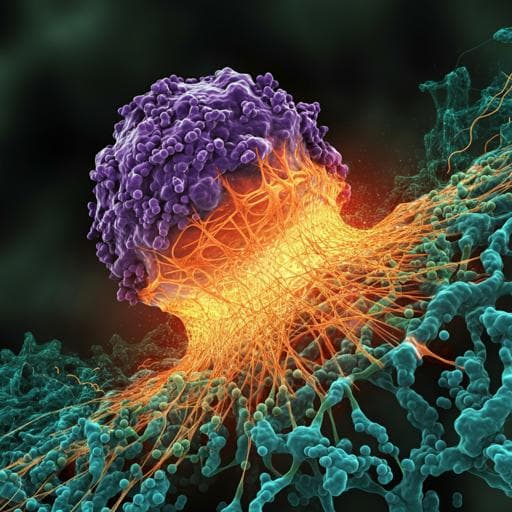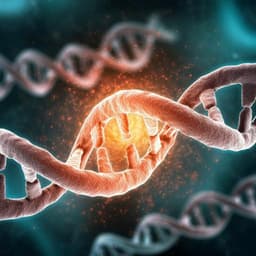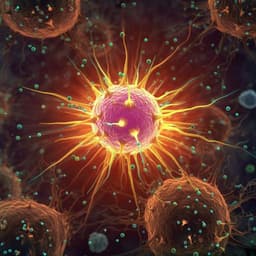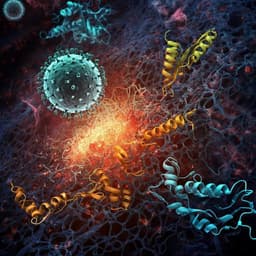
Medicine and Health
ROS induces NETosis by oxidizing DNA and initiating DNA repair
D. Azzouz, M. A. Khan, et al.
Discover how reactive oxygen species play a crucial role in the formation of neutrophil extracellular traps! This research, conducted by Dhia Azzouz, Meraj A. Khan, and Nades Palaniyar, dives into the mechanisms of NETosis, revealing how DNA damage and ROS lead to this fascinating phenomenon.
~3 min • Beginner • English
Introduction
NETosis is a unique form of programmed cell death that neutrophils undergo when exposed to agents such as phorbol myristate acetate (PMA), bacterial LPS, Staphylococcus aureus (RN4220), or Pseudomonas aeruginosa. These agonists activate NADPH oxidase (NOX), which generates reactive oxygen species (ROS) and subsequently activates mitogen-activated protein kinases (extracellular signal-regulated kinase, p38, c-Jun N-terminal kinase). Prior work showed that genome-wide transcriptional firing initiated by kinase cascades is necessary to decondense chromatin and drive NETosis; transcription initiation, but not translation or new protein synthesis, is essential. The assembly of transcription machinery facilitates chromatin decondensation at promoter regions. However, the relevance of DNA repair to NETosis is unknown. NOX-dependent NETosis agonists induce massive ROS in neutrophils, and inhibiting ROS production blocks NOX-dependent NETosis, but how ROS executes NETosis remained unclear. The authors hypothesised that ROS induces DNA damage and that repairing extensive DNA damage leads to chromatin opening and subsequent NETosis. ROS can oxidise DNA bases (e.g., converting guanine to 8-oxoguanine). When transcription machinery stalls at damaged DNA, repair machinery assembles and opens chromatin for repair; damaged bases can also be repaired independently of transcription. DNA repair components relevant to oxidative lesions include 8-oxoguanine glycosylase (OGG1), proliferating cell nuclear antigen (PCNA), apurinic/apyrimidinic endonuclease (APE1), poly-ADP ribose polymerase (PARP), DNA ligase, and repair polymerases β and δ. Base excision repair (BER) and nucleotide excision repair (NER) can repair damaged bases. In BER, the oxidised base is removed by a glycosylase, followed by strand cleavage by APE1. PARP binds single-strand DNA ends and generates poly ADP, recruiting repair machinery including DNA ligases. PCNA forms a trimeric clamp enabling repair polymerases β and δ to complete repair (long-patch BER or NER). Assembly of the early enzymes (APE1, PARP, DNA ligase) and nick generation is sufficient to induce extensive chromatin decondensation. Therefore, the study tests the importance of ROS-mediated DNA damage and key DNA repair steps in driving chromatin decondensation and NET formation.
Literature Review
Methodology
Ethics: Protocols approved by The Hospital for Sick Children ethics committee; informed consent obtained; methods followed institutional guidelines.
Neutrophil isolation: Peripheral blood from healthy donors collected in K2 EDTA tubes. Neutrophils isolated using PolymorphPrep with modifications: hypotonic RBC lysis (0.2% NaCl), restoration to isotonic with 1.6% NaCl in 20 mM HEPES pH 7.2, washes in 0.85% NaCl/10 mM HEPES pH 7.2, resuspension in RPMI with 10 mM HEPES pH 7.2.
NETosis quantification (SYTOX Green plate reader): Cells at 5 × 10^5/ml with 5 μM SYTOX Green in 96-well plates. Inhibitors added for 1 h at 37 °C before stimulation. Stimuli: media (negative control), NOX-dependent agonists (e.g., PMA, LPS), Triton X-100 (positive control). Inhibitors and typical concentrations: APE1 inhibitors CRT0044876 (125 μM) and APE1 Inhibitor III (50 μM); PARP inhibitors BS1201 (100 μM) and PJ34 (50 μM); DNA ligase inhibitor L189 (100 μM); polymerase β inhibitor AM-TS23 (25 μM); PCNA:polymerase interactions inhibitor T2AA (25 μM); DNA polymerase inhibitor Aphidicolin (50 μM). Fluorescence (Ex 485 nm/Em 525 nm) measured every 30 min for 240 min; NETosis index calculated relative to 1% Triton X-100.
Confocal imaging: Cells at 1 × 10^6/ml plated in 96-well plates, preincubated with inhibitors 1 h, stimulated for defined times, fixed in 4% PFA overnight, permeabilized with 1% Triton X-100 for 25 min, blocked with 2.5% BSA in PBS for 1 h. Primary antibodies: anti-PCNA (F-2, 1:250), anti-8-oxoguanine (MAB3560, 1:250). DNA stained with DAPI (10 μM, 1:333). Imaging on Olympus IX81 spinning disk confocal with Hamamatsu EM-CCD and Yokogawa CSU x1.
siRNA knockdown in HL-60-derived neutrophils: HL-60 cells cultured in DMEM + 10% FBS; differentiated with 7% dimethylformamide (media replaced after 2 days). On day 4, transfected with 25 nM siRNA (scrambled, APE1, or PARP1; Qiagen) using HiPerfect (2 μl/100 μl). After 24 h knockdown, cells washed and resuspended in serum-free RPMI. PARP1 siRNA target: 5'-CCGAGAAATCTCTTACCTCAA-3'; sense 5'-GAGAAAUCUCUUACCUCAATT-3'. APE1 siRNA target: 5'-CAGGACAGAGCCAGAGGCCAA-3'; sense 5'-GGACAGAGCCAGAGGCCAATT-3'. Knockdown confirmed by Western blot (anti-APE1, anti-PARP, anti-GAPDH; HRP detection).
In-cell ELISA for 8-oxoG: Cells (5 × 10^6/ml) plated in 96-well plates, treated with PMA or LPS for 2 h at 37 °C, fixed in 4% PFA overnight, permeabilized (1% Triton X-100, 25 min), blocked (2.5% BSA, 1 h), probed with anti-8-oxoguanine (1:250). Fluorescence quantified on POLARstar OMEGA. Complementary immuno-confocal imaging performed.
Bacterial NETosis assays: Neutrophils incubated with MOI 20 Staphylococcus aureus (RN4220) or Pseudomonas aeruginosa for 4 h with or without DNA repair inhibitors (same as above). NETs assessed by microscopy and SYTOX Green assay.
Statistics: GraphPad Prism 7. One-way ANOVA with Dunnett/Tukey post-tests, two-way ANOVA with Dunnett’s post-test, and Student’s t-test as appropriate; variance similar between groups; data as mean ± SEM; significance at p < 0.05.
Key Findings
- ROS generated by NOX during NETosis induces extensive oxidative DNA damage in neutrophils, evidenced by increased 8-oxoguanine (8-oxoG) throughout NET DNA by immuno-confocal imaging and in-cell ELISA. PMA (25 nM) and LPS (5 μg/ml) significantly increased 8-oxoG versus media control (n = 6; p < 0.05).
- PCNA, stored in the cytoplasm of resting neutrophils, translocates to the nucleus/perinuclear regions early after NETosis induction (PMA 60–120 min; LPS 30–60 min) and later decorates NET DNA (≈4 h), indicating assembly of DNA repair machinery genome-wide during NETosis. MPO co-localization confirmed NETs.
- Pharmacologic inhibition of early BER/NER steps suppresses NETosis induced by PMA: APE1 inhibitors (CRT0044876, APE1 Inhibitor III), PARP1 inhibitors (BS1201, PJ34), and DNA ligase inhibitor (L189) reduced NETosis by SYTOX assay and confocal imaging (n = 3; p < 0.05 vs PMA alone).
- Inhibition of later repair steps did not suppress PMA-induced NETosis: inhibitors of PCNA:polymerase β/δ interactions (T2AA) and polymerase β activity (AM-TS23), or polymerase inhibition (Aphidicolin), did not reduce NETosis (functional validation of inhibitors performed separately).
- siRNA knockdown in differentiated HL-60 neutrophils confirmed genetic requirement for early repair steps: APE1 or PARP1 knockdown reduced NETosis induced by PMA (150 nM) or LPS (15 μg/ml) at 6–8 h; knockdown confirmed by Western blot (n = 4; p < 0.05).
- The same early DNA repair inhibitors (APE1, PARP1, DNA ligase) significantly suppressed NOX-dependent NETosis induced by bacteria: Staphylococcus aureus (RN4220) and Pseudomonas aeruginosa at MOI 20 (n = 3; p < 0.05).
- Mechanistic model: Excess ROS causes widespread DNA base oxidation (e.g., guanine to 8-oxoG). Recruitment and assembly of early DNA repair machinery (APE1 incision, PARP activation, ligase recruitment) generate DNA nicks and extensive chromatin decondensation sufficient to drive NETosis; later steps (PCNA/polymerase-mediated synthesis) are not required under strong NOX-dependent stimulation.
Discussion
The study addresses how ROS drives NETosis by demonstrating that ROS-induced oxidative DNA damage and the ensuing early DNA repair processes are key drivers of chromatin decondensation leading to NET release. Upon NOX activation by PMA, LPS, or bacteria, ROS production leads to both activation of MAPK cascades and genome-wide transcriptional firing, as well as oxidation of DNA bases (notably 8-oxoG). Transcriptional machinery can stall at DNA lesions, which promotes recruitment of BER/NER components. PCNA, stored cytoplasmically in resting neutrophils, rapidly translocates into nuclei after stimulation and later associates broadly with NET DNA, indicating widespread engagement of repair processes. Functionally, blocking early repair steps (APE1 incision, PARP activation, DNA ligase involvement) suppresses NETosis across multiple agonists and pathogens, whereas inhibiting later steps (PCNA interactions and polymerase activity) does not, suggesting that chromatin opening and nick generation up to the ligation step are sufficient to drive NETosis. These findings integrate with prior evidence that transcription initiation is necessary for NETosis, supporting a model where transcription-coupled DNA repair and possibly global genome repair together create genome-wide chromatin unwinding that culminates in NET release. The data also reframe PCNA’s cytoplasmic storage in neutrophils as serving roles in DNA repair and NETosis regulation, not solely apoptosis. The implications are that DNA repair machinery, beyond its canonical genome maintenance functions, orchestrates chromatin dynamics during innate immune responses, and that selective targeting of early repair steps could modulate pathological NETosis in diseases such as lupus, autoimmune disorders, and sepsis.
Conclusion
This study identifies ROS-induced DNA damage and the early steps of DNA repair (APE1, PARP1, DNA ligase) as essential drivers of chromatin decondensation and NETosis. PCNA translocation and widespread association with NET DNA highlight the extensive engagement of repair machinery during NETosis. Pharmacologic inhibition and genetic knockdown of early repair components suppress NOX-dependent NETosis induced by chemical agonists and bacteria, whereas inhibition of later repair steps does not, indicating that nick formation and initial repair assembly are sufficient for NET induction. These findings provide a mechanistic link between ROS, DNA damage/repair, transcriptional firing, and NET formation. Future research should delineate the relative contributions of BER subpathways (short- versus long-patch), define contexts where PCNA and polymerases may regulate distinct NETosis forms, explore transcription-coupled versus global genome repair contributions, and assess therapeutic efficacy and safety of early DNA repair inhibitors in NET-driven diseases.
Limitations
- Primary human neutrophils are not amenable to siRNA knockdown; genetic validation was performed in differentiated HL-60 cells, which may not fully recapitulate primary neutrophil biology and required longer stimulation times.
- The base removal step was not directly targeted due to lesion-specific glycosylases; thus, contributions of specific glycosylases (e.g., OGG1) were not dissected.
- While inhibitors of PCNA and polymerases were functionally validated in other assays (data not shown), lack of effect on NETosis under strong NOX-dependent conditions does not exclude roles for these factors in other NETosis contexts or stages.
- The study predominantly assesses strong NOX-dependent stimuli (PMA, high-dose LPS, MOI 20 bacteria); generalizability to weaker stimuli or NOX-independent NETosis remains to be determined.
- Quantitative biochemical measures of chromatin nicking/decondensation were inferred from inhibitor effects and imaging rather than direct genome-wide mapping of repair intermediates.
Related Publications
Explore these studies to deepen your understanding of the subject.







